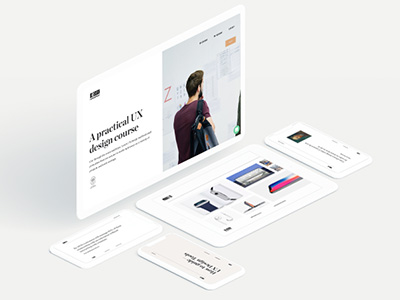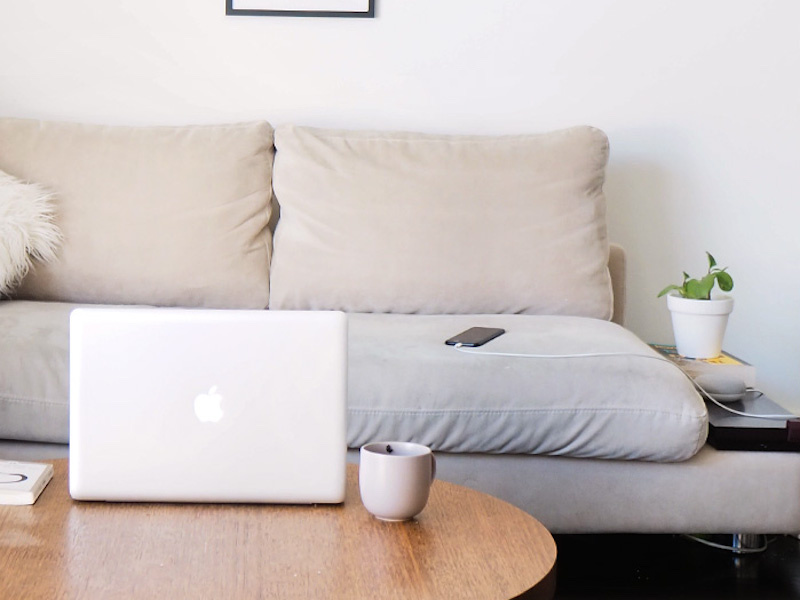Nguyen Le is a busy guy. From creating and running his online UI/UX course to managing a blog, he’s got a lot going on! To keep things organized, Nguyen prefers a minimal workspace filled with his essentials. Since having kids and freelancing full time, he’s also had to make some major adjustments to his daily, weekly, and even monthly routines. Keep reading to find out what specific structures and mindsets Nguyen has implemented that work best for his productivity and lifestyle.
Where do you work? Tell us about your space.
For seven and a half years of my career, I worked at various design agencies with very nice offices. For the last four years however, I’ve worked at home in a small and modest home office that I set up. No top-level harbour views, elevators, or nice meeting rooms but the commute time to work is ten seconds every morning and I get to see my wife Phuong, and two children, Theo and Miles every day. And that beats harbour views any day!
My workspace is filled with books, magazines, and photos of people that inspire me. Books are an inspiration for me so I always have them on hand to remember key passages about life, business, or design. If it’s a visual problem, I refer to different design books and magazines that are in my library. Sometimes when I’m stuck on a problem, I can read a passage from Meditations by Marcus Aurelius and approach it from a more philosophical and stoic point of view—or understand how Ray Dalio’s principles can be applied to a situation or problem I’m solving. It’s important to zoom out from our work as designers and look at the big picture. So having books in my office is like having all these mentors and wisdom that help me figure things out.

In my workspace, I have a 27” iMac which is my main computer that sits in my office but sometimes I work on my laptop in different areas of the house to keep things fresh. When I’m planning or writing articles for Verse, I tend to use a MacBook Pro which I use on the couch, on the dining room table, or outside on our balcony. My space is pretty clean and minimal most of the time. However when I’m working on a project, I have a ton of things on my desk to immerse myself into the work and all information related to it. So it can get chaotic and messy when I’m in full blown creative work mode.
What hardware and software do you use to create your designs?
For hardware I use 27” Apple iMac and a Macbook Pro. Not the latest models (actually both are a few years old). I also test my designs on my iPhone 7. I use Apple headphones and my Sonos speaker to listen to music or podcasts which is a requirement for when I’m designing. I’m old school so I also use a Samsung printer to print notes and other things out. I’m a fan of good old pen and paper and annotate a lot of things on random printouts and pages as well as sketching, wireframing, and note taking in my Moleskine. I put my monthly goals on sticky notes that I stick on the wall as a reminder of what I’m working on or towards.
My software setup includes:
Sketch: For most of my product design stuff: websites, apps, UI work. The hands-on production work.
Photoshop: For image editing, quick mockups, or conceptual work. I also use it for my Dribbble shots as I enjoy the flexibility of the tool.
InDesign: When I’m creating print related stuff, editing invoices, working on ebooks like my type playbook, and creating proposal docs etc.
Principle: For prototyping my projects. Great for user testing and for testing micro-interactions, animations, and mobile and desktop experiences. There’s a lot of great prototyping tools out there today but for most of my needs Principle works very well.
Invision: For client feedback, prototyping, and creating user flows.
Milanote: For creating moodboards and styleboards. It’s a client collaboration tool and a place to map some of my notes/thoughts digitally.
Zeplin: For project handoffs with developers and clients.
Slack: For client communication and to chat with my private design community. It’s full of my wonderful students from the Process Masterclass where we talk design and share work and interesting links.
Keynote: To create presentations, documents, and class slides.
Dropbox: For file sharing and delivery both for clients and my students.
I feel like designers sometimes get caught up on hardware and tools. But having sound design fundamentals and good soft skills such as communication is much more important. Tools are a means to end—they help us solve problems but don’t define us.
Tell us about your routine (or lack of one.) How do you structure your days to get things done?
By nature, I am not a routine type of person. Before having kids I used to work with a super flexible schedule. I’d play tennis, design, work, and walk our corgi, Butters, at random hours. I’d work solidly three to four days a week on paid projects and then take the rest of the time off to learn, read, do personal projects, and play tennis. That worked really well for the first year I started freelancing which was in 2014.
Since then we’ve had two kids and that go with the flow approach doesn’t work anymore, unfortunately. Sleep deprivation and the attention of two young children does that to you. Now things are a bit more structured and ordered for me to be productive!

The way I get things done is by employing two mindsets. The first mindset is of the business owner— one who strategizes and plans out what goals and objectives they are trying to hit for the quarter and for the year. Once I know that, I can focus on each quarter and break it down by month, week, and day.
Every week I break down key activities that I want to complete and each day is mapped out with one primary task and then secondary tasks. A primary task is based on Pareto’s principle or commonly known as the 80/20 principle. It’s based on the idea that 80% of results come from 20% of activities. So I try to focus on the 20% that creates most of the results. A question I ask myself is: “What is one thing I can do today that will help me the most to reach my monthly and quarterly goals?” Most of the time it’s the uncomfortable thing—like following up on an important lead, writing that content I’ve been holding off, or that sales email etc. I do the primary task first and as long as I get it done, the day is very productive. Then I do the secondary tasks like answering emails, chatting on slack, and doing the fun parts of a design for example. If I’m being efficient, at the end of the week I’ll do a retrospective and see how well I’ve done. At the end of the month, I’ll see if I’ve hit my goals and where I can improve things.
As for specific day to day routine, I generally watch the kids from 7:30 am until 10:30am-11am. My work day starts after that and finishes at around 5:30pm-6pm. At night I’ll do a bit of reading—either books, blogs, or articles. Throughout the year I take a few months off either to vacation or spend more time with my family. Then I’ll have two months of super productivity where I’ll work six days a week. It’s a bit unconventional but it works for my family and me. That’s how I get things done.
How do your space, tools, and habits benefit you? What about those things do you think needs improvement?
The best part about my space is I don’t have to commute to work. Not everyone is suited to working at home but I’m a bit of a homebody so it suits my personality. For the first few years, I was very productive. But as mentioned above, having chosen to work at home and then having two kids, staying focused and productive can be difficult at times. With one child it wasn’t too hard but with two it’s a whole other ball game. This is why I’ve been very purposeful with my time and planning.
I’d say staying focused is something I’m working on. But overall I’m happy with how things are. I’m grateful that I get to live and do the kind of work that I do and that I get to share the passion with other designers.
Want to keep up with Nguyen? Find him on Dribbble, Instagram, and at Verse-co.com
Find more Interviews stories on our blog Courtside. Have a suggestion? Contact stories@dribbble.com.











